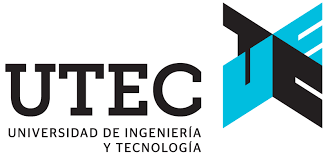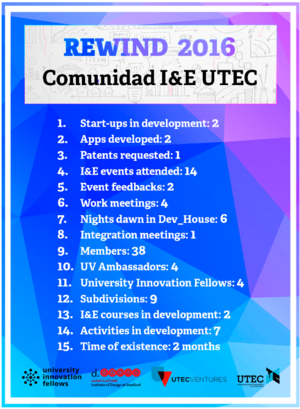Resource:How to create a community leveraging your business accelerator
Contents
BACKGROUND
The content of this wiki page was gathered from an interview with Hans Figueroa Guaylupo, and many of the examples found on this page are from his experiences.
This is how Hans made an impact using his university’s accelerator at Universidad de Ingeniería & Tecnología (UTEC):
One of the concerns with UTEC’s existing accelerator was that they focused mainly on building and helping startups and wasn’t or at all concerned with creating activities that promoted innovation to the community such as hackathons.
GETTING STARTED
Plan
First of all approach the key people at your university’s accelerator (if your university does not have one, then proceed to creating one), let them know that you are part of the University Innovation Fellows program.
Win their confidence by telling them your good intentions (or in other words, your goals) that could improve the accelerator in someway. Organize the stakeholder meeting and use that opportunity to discuss the various aspects that you plan to make an impact on with the help of the accelerator. Proceed to get an approval with the accelerator.
Now that the accelerator has agreed to help or partake in someway, plan a meeting to make arrangements on how both sides can make a win-win situation. Do whatever you can, and bargain if you must. At this point you need to know the needs from both sides.
Remember to:
Emphasize on the idea of community creation and with the involvement of many students the greater the impact. In return for their cooperation, volunteer your time (or get others) to help them with needs or obstacles that it might face.
People
Next, create community, start with a group of friends, organize an integration meeting and invite people of the business accelerator to these meetings, in order for everyone know each other, share words, have an enjoyable time and establish good relationships. Your best resource as a University Innovation Fellow are the other fellows, especially those in your leadership circle. Your mentors are your next best connection, because they can help you decide on other potential stakeholders and other professors and faculty with an entrepreneurial mindset. The Directors of your university are important to get involved because they make the decisions on access to areas and funding that will be key to your success.
Your University’s Career Services Department will be able to engage professionals in different industries that may be interested in the projects implemented in the accelerator, aka the money behind the operations. It is also important to bounce your ideas off of students on campus to offer them an avenue to pursue that creative spark they have. If possible, reach out to other ventures in your area that have similar missions to get involved.
As you pick up this critical mass of people, there are more hands turning the wheel towards success. Make sure you keep it moving in a forward direction by getting the word out by means of social media and other outlets like the news, or even flyers.Also emphasize that the community was created from the classmates who took the University Innovations Fellow program at Stanford, that draws the attention of students and gives confidence.
Maintain
Maintain your community by working on it every day. It is always good to measure where you have come from, to where you are now, so this stuff is important! Always try to quantify things like how many start-ups are formed in the community, or how many applications are developed, or how many I&E events the community attends, etc. Campus accelerators are popping up on international campuses and idea centers, so this community idea is spread all over the world!
It is important to keep the community engaged. As people become invested, things tend to take off quickly. Make sure your community is welcoming and don’t be afraid to let other people take the reigns as it is easy to spin out. If people are inspired, remember that this community is their avenue to reach for the stars.
QUESTIONS AND ANSWERS
The following is a brief excerpt from an interview with Hans Figueroa Guaylupo, and may help you better understand successful community leveraging of a campus accelerator.
· Why did you decide to work with your campus accelerator?
There are a lot of startup groups, but they were a more community oriented venture. The people that worked there are professionals and it was an advantage that the students knew them before UIF because to work with them you need to have confidence in speaking with them.
· What was the biggest challenge that you have faced?
Organizing a community and getting everyone to work together was the most difficult challenge that he had to overcome. Accomplishing something like this was unprecedented at his university, so setting up the groundwork was a challenge, as well as figuring out where to start in the first place. Another challenge was learning to compliment different talents and subdivide groups getting everyone in one room to plan and discuss was also a challenge
· What was the overall model of your accelerator? How did it work?
There are two parts: Ventures and Community. If anybody has a project idea in the community, there are days when they can pitch the ideas and get feedback and help to proceed with their ideas. They have autonomy in implementing the projects. The directors encourage them to have control over their initiatives and they are allowed to request funds when needed.
· How much funds did they have to provide? (Did they get money for activities or the space?)
The community started about two months ago since November 1st. They held two activities thus far. They participated in the international Festival of social innovation, and are currently planning for activities for next year. The amount of money was set by the area? of UTEC (The community received about 5000 Soles, About $ 1484 dollars).
There is an event labeled UTEC networking, It’s like a job fair, companies come to UTEC and students have to provide a pitch of about 2 min to convince the companies that they are great candidates. With the career services, they implemented a workshop that focused on improving students skills in giving elevator pitches. They have enough funds for now, since the community was established two months ago. But they may eventually need to fundraiser at a later stage. There are currently 40 members in the community. Union and integration is important to form a community that share a common goal. There are associations like IEEE which offer professional development opportunities but they are not as good as other organizations because they are not like a community since they only help with improving the I&E ecosystem through more structured means.
· Need and goal (what you did to assess the need and how this would fill that need). And what was the need at the university for this project and how did you test the depth and importance of this need?
Formed lots of relationships with people from around the university and listened to what they wanted from their university, and what kind of changes they would like to see. Asked professors, directors, students and everyone said they needed an ecosystem and community where startups would be supported and could thrive. They realized there was only one startup created at UTEC, but now there are four startup because once you have one many others will follow.
EDITORS
Tobiloba Komolafe
Cheryl Fong
Alyssa Norris
Daniel Yates
Erin Esco
Josef Pishek
Marouane Smaili

